|
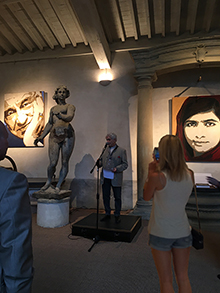
---------------------

People's Portraits

Edgar Morin

Louise Bourgeois
|
Davide Lombardo and Fabrizio Ruggiero- excerpt from a conversation:
February 13th 2017 at Villa La Pietra, New York University, Florence.

The Transformative Power of Art , UN headquarters, New York, June 2015
DAVIDE LOMBARDO:-Let’s start from the portraits that went to the UN and are coming to La Pietra. How this project developed? How it became an exhibition?-.
FABRIZIO RUGGIERO:-In 2015 the distinctive General Assembly building of United Nations in New York, , by Brazilian architect Oscar Niemeyer, had just been renovated to celebrate the 70th anniversary of the signing of the United Nations Charter.
At that time was President of General Assembly H.E. Sam Kahamba Kutesa, a leader from Uganda. The central theme of his presidency has been transforming and changing people's lives across the world, in a sustainable manner.
He asked for the celebration the 70th anniversary of the signing of the United Nations Charter an art exhibition informed by this aspiration.
The exhibition, which took place under the United Nations "2015: Time for Global Action" campaign, was also destined to raise awareness about climate change and our fragile ecosystems.
I imagined this show with Idanna Pucci and Terence Ward as formed by two apparently conflicting elements that coexist through a common root.
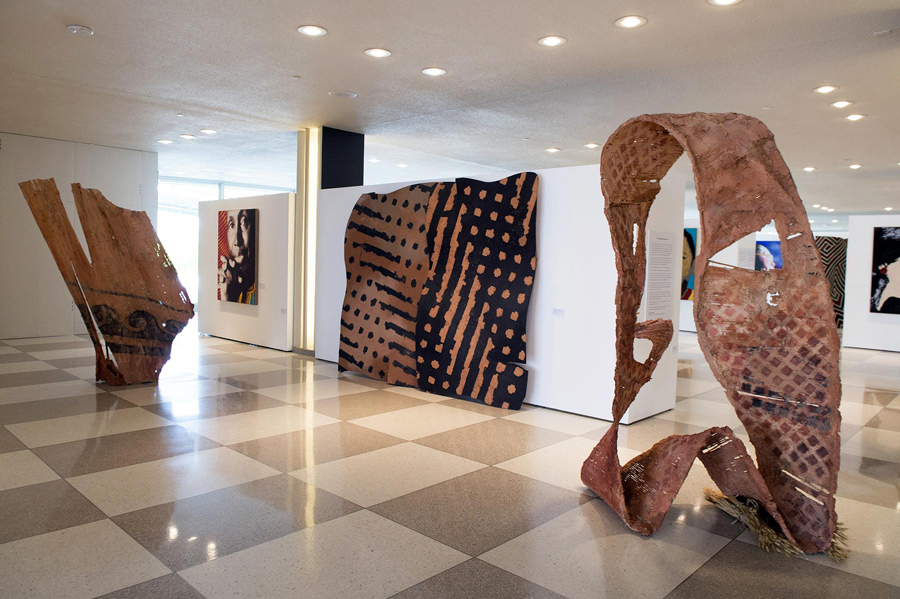 The Transformative Power of Art , UN headquarters, New York, June 2015 The Transformative Power of Art , UN headquarters, New York, June 2015
The first element is formed by abstract sculptures characterized by patterns common to different cultures and the second is a series of portraits.
The sculptures that were exhibited are made of many natural elements provided by nature's bounty from all parts of the world. They bear testimony to nature's resilience in the face of human-made challenges. The sculptures are like totems, silent performers, and, by their fragility, reminders of the perils facing Mother Earth and humankind.
The objective of the exhibition was to show that art creates bridges where politics divide. It was designed with the conviction that artistic impulse always carries seeds of redemption.
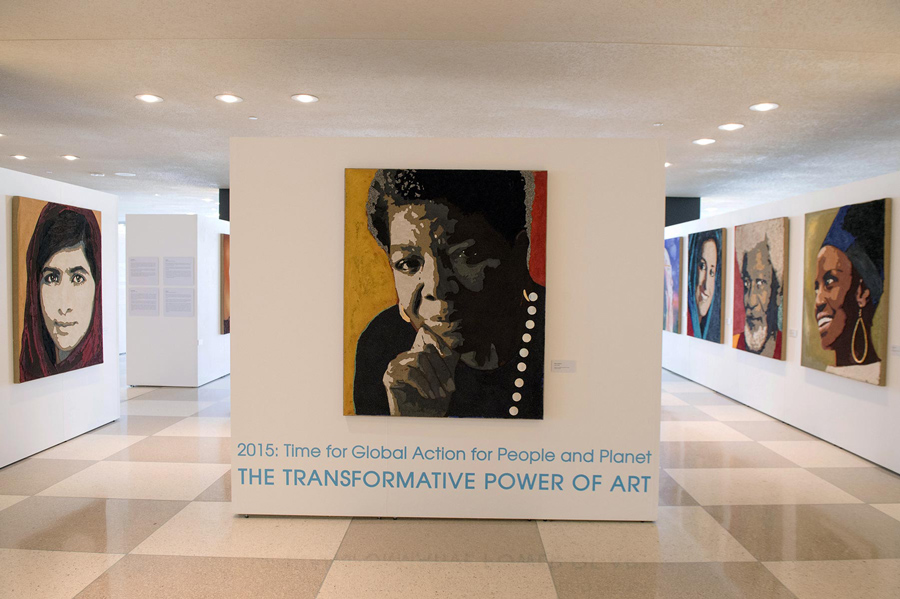
DAVIDE LOMBARDO:-How did you choose the sitters for the UN, what kind of people are they? What they have in common? Tell us how you work on a sitter-.
FABRIZIO RUGGIERO:-The 16 accompanying portraits represent people in this case they are mainly artists, writers, poets, from all continents who, during their lifetime, contributed to the common good of humanity in one way or another and have transformed the way we think. The portraits are meant to project the power of generosity that touches the human heart and conscience. The men and women who are represented never lost sight of the most vulnerable.
They are: Pierre-Claver Akendengue (Gabon), Maya Angelou (USA), Joan Baez (USA), Audrey Hepburn (UK), Vassily Kandinsky (Russia), Umm Kulthum (Egypt), Gong Li (China), Miriam Makeba (South Africa), Edgar Morin (France), Fatemeh Motamed-Arya (Iran), Okot p'Bitek (Uganda), Satyajit Ray (India), Sebastiao Salgado (Brazil), Wole Soyinka (Nigeria), Ngugi Wa Thiong'o (Kenya), and Malala Yousafzai (Pakistan)-.
DAVIDE LOMBARDO:-Would you share your relationship with one of these in particular? Why did you include this particular sitter? Tell us also how do you see your sitter in your portrait
FABRIZIO RUGGIERO: Since the first topic of this La Pietra Dialogues is IDEAS, One of portraits that I will show in La Limonaia is of a free thinker of Indian origin that I met in my youth, when I was in my early twenties.
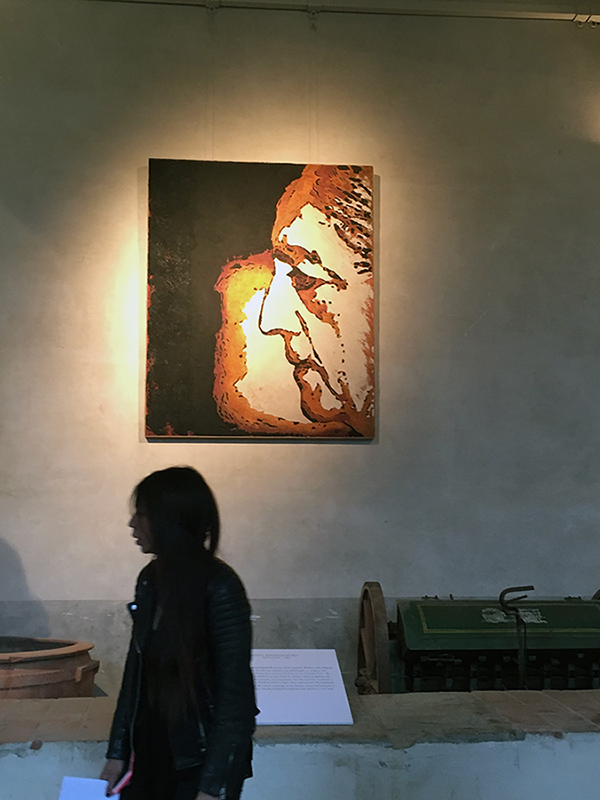
Limonaia, Villa La Pietra, NYU Florence, portrait of Jiddu Krishnamurti
His name is Jiddu Krishnamurti and he was saying that Ideas and ideals have something in common with belief, prejudice (and faiths).I was quite affected by that statement and I would like to know your impressions, just let me develop a bit more..
Our prejudices, our ideals limit the capacity and the energy required to think, to observe and examine together. Thinking together is tremendously important because we have to face a world that is rapidly disintegrating and we need to discover for ourselves what lies behind all the misery and violence in the world. Thought has done marvelous things but has also brought great destruction and terror in the world. We have to understand the nature and the movement of thought, examining the very structure of thought and its enormous vitality.
What is thinking? How do we know what we know? Through the awareness of our five senses we have understanding of an object or emotion, understanding is experience; from experience we get knowledge that is stored up in the brain as memory. And from memory thought raises.
So thought is always old, the product of our conditioning and from thought we act repeating endlessly the cycle: sensation, experience, knowledge, memory, thought, action; this is the way our minds are conditioned.
Apart from a sparkling bulb, which image comes to our mind with the word "idea"?
According to Plato, ideas are the only true eternal realities, outside of time and space, the subject of science, as opposed to this sensible world in which we live and that is only a pale image of those eternal realities.
In modern times the term idea came instead taking on more and more the significance of mental entities, the content of thought. But if thought is the product of past, conditioned, how can new ideas sparkle out?
So it may be of interest to discover where we need thought and where we can be completely free from the conditioning of thought so that new, genuine ideas can spring out...for the benefit of all living beings.
DAVIDE LOMBARDO:-In one of the texts about the portraits and in your own portfolio the portraits are defined effigies; can you tell us what you would think the difference is between a portrait and an effigies (the more fashionable word would be icon, why you preferred effigy?)
FABRIZIO RUGGIERO:-The word effigy comes from the Latin verb effingĕre and means to perform, to reproduce in relief.
Effigy is also a human or divine subject represented through a drawing or sketch, embossed so that stands out in relief and also the artistic product that reproduces this subject.
Effigy is all physical traits that are exhibited by a person: his appearance and features.
The icon is, in its original meaning, is a sacred image that serves as a bridge between the world of everyday life and a spiritual universe that is not achievable or describable dimensionally.

Limonaia, Villa La Pietra, NYU Florence, portrait of Wole Soyenka.
The people I portrayed contributed to the common good of humanity placing Human Being at the centre of everything we do out of any religious context. So I think that the word effigy applies better then icon to these people. Then if you look close to my paintings you will notice that they are made of thick layers, so in relief as the word effigy suggests.
I would like to add that according to the dictionary the word "people" indicates the entire body of persons who constitute a community, tribe, nation, or other group by virtue of a common culture, history, religion, or the like: whatever the reason that links persons in a community of PEOPLE, they are limited and often divided from other communities, and where there is division there is conflict. So instead of PEOPLE, I would suggest to consider HUMAN BEINGS, a term that puts all of us under the same roof...We should focus on what unites more than on what divides.
DAVIDE LOMBARDO:-What are you working on these days?
FABRIZIO RUGGIERO:-We are used to think of future as something that comes in front of us, I prefer the idea from other cultures that ahead of our eyes flows only the past , the future is behind our shoulders, so we cannot see it before it happens...
Pliny the Elder, in his Naturalis Historia tells us the history about the origin of painting:-… but they all agree that the art of painting originates from the habit of tracing with a line the contour of the human shadow-. Focusing one’s own attention on the concept, one can find more than that in Pliny’ statement: Painting, the art of painting, as tracing the border-line between light and shadow, clarity and darkness, known and unknown, order and chaos…The art of painting as a process to develop awareness and understanding towards ourselves and the reality around us, marking the border line between opposites, thus a middle path, a search for balance and equilibrium. From this point of view the art of painting is, always Modern. Modernus is what has -modus - meaning in Latin “in this very moment, right now”. Then modern is the border line between the past and the incoming moment. The art of painting as a process to bind attention to here and now; a wonderful way to be free from the oppression of next and from the idea of immortality, indeed.
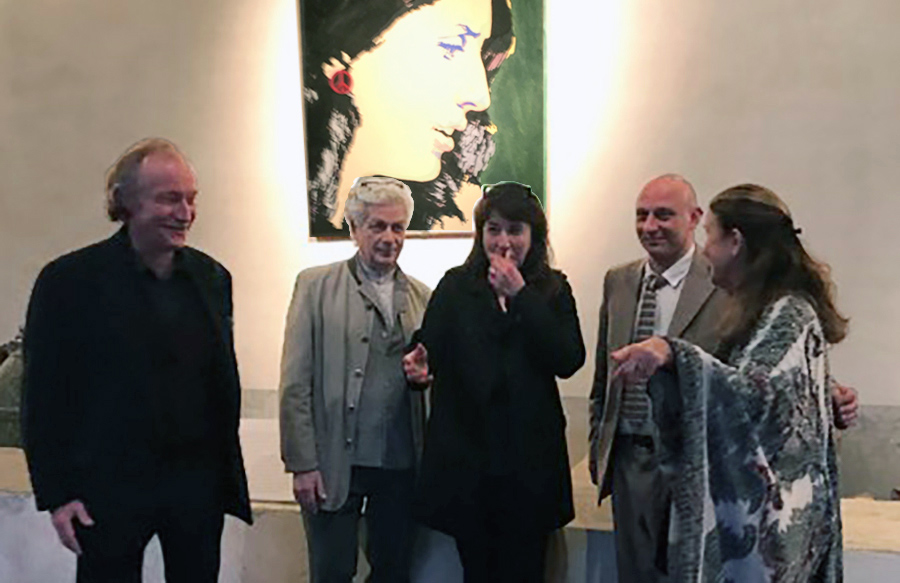
Terence Ward, Fabrizio Ruggiero, Ellyn Toscano, Davide Lombardo, Idanna Pucci, opening The Transformative Power of Art and Ideas,Fresco Portraits by Fabrizio Ruggiero, Limonaia di Villa La Pietra, New York University, Florence.
Il progetto Ideas, People, Change di cui la mostra fa parte è stato coordinato da Davide Lombardo, NYU Florence.
|


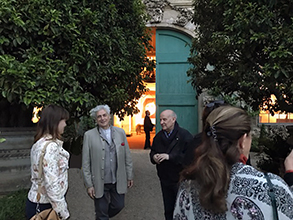

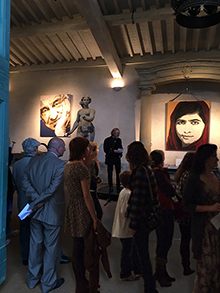






 The Transformative Power of Art , UN headquarters, New York, June 2015
The Transformative Power of Art , UN headquarters, New York, June 2015 




